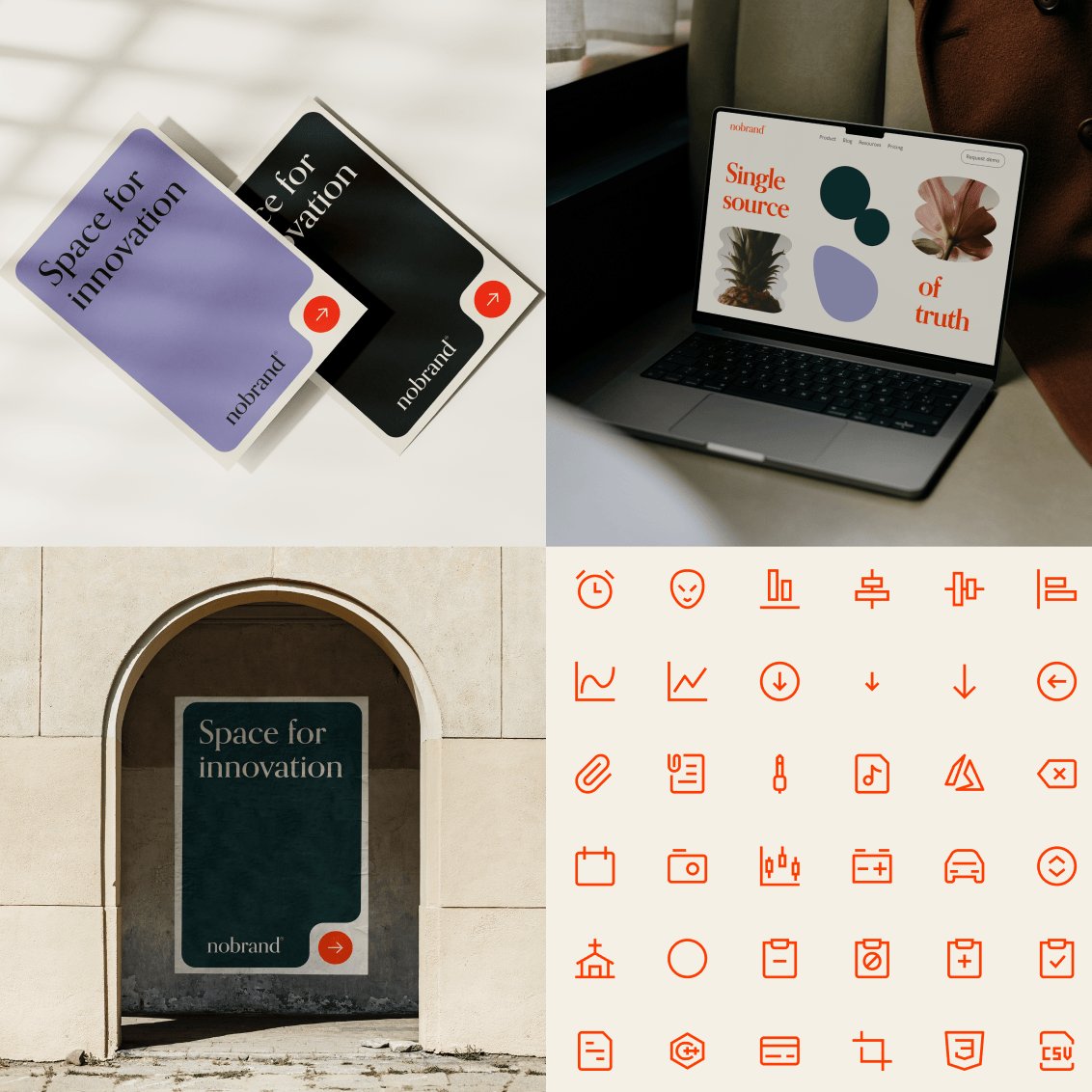Key takeaways
- Marketing collateral encompasses a variety of materials, including digital assets like website content, social media visuals, and email templates, as well as traditional printed items like brochures and business cards.
- Marketing collateral plays a crucial role in brand growth by establishing a consistent brand identity, enhancing customer engagement, and supporting sales and marketing efforts.
- To efficiently organize your marketing collateral, centralize all assets in one location such as a DAM system, ensuring easy access and avoiding duplicates.
- Implementing a robust template system using tools like can significantly enhance the efficiency and consistency of creating marketing collateral.
What is marketing collateral?
Marketing collateral refers to a collection of copy, media, and assets that support the promotion of products or services. These resources help convey the brand’s message, engage potential customers, and support various marketing and sales efforts.
Today’s marketing materials center on digital assets — website content, social media visuals, and email templates — which allow for dynamic and interactive engagement with target audiences.
While many companies lean more toward digital collateral, there’s still a need for printed materials such as brochures, flyers, and business cards. For example, hotels use printed flyers and posters in their lobbies to inform and educate customers.

Why do brands need marketing collateral?
Using marketing collateral supports brand growth by providing consistent, engaging, and informative materials that strengthen brand identity, facilitate customer education, and guide targeted marketing efforts.

Driving brand recognition and consistency
Marketing collateral helps establish and reinforce a brand’s identity. By using consistent branding across various touchpoints, you can build trust and reliability among your audience.
Consistent use of logos, colors, fonts, and messaging across all materials also ensures the brand is easily recognizable — no matter where the customer encounters them.
Boosting customer engagement and conversions
High-quality, well-designed, and well-targeted marketing collateral captures the attention of your audience. Videos, infographics, and interactive websites can keep people interested and invested in your brand.
Effective marketing collateral guides potential customers through the sales funnel; clear calls to action and compelling content further boost conversion rates.
Supporting sales and marketing efforts
Branded collateral is an effective tool for sales teams to communicate the value of products or services — brochures, case studies, and presentation decks help explain complex concepts and close deals.
Consistent messaging and visuals, social media graphics, email templates, or landing pages support marketing efforts and ensure that campaigns are cohesive and professional.
Sharing your collateral with potential customers helps educate them about your products or services. White papers, how-to guides, and explainer videos can provide in-depth information and enable people to make informed decisions.
14 types of marketing collateral
To support customer education and engagement, teams use an array of marketing collateral. Here are 14 types that help you achieve your branding, marketing, and sales goals.
Digital marketing collateral
- Websites and landing pages: A comprehensive digital presence for your brand, providing information about products, services, and the company. Landing pages are designed to capture leads or drive a desired action (i.e., view a specific product) and are often linked to marketing campaigns.
- Social media graphics: Visual content designed for sharing on social media platforms. The goal is to engage audiences and promote brand messages. Examples include Instagram posts, Facebook banners, and TikTok videos.
- Logos: Graphic marks or emblems that promote public brand recognition. Logos are key elements of a brand’s identity and are used across all touchpoints.
- Email templates: Pre-designed formats for marketing emails, ensuring consistent branding and the efficient creation of professional-looking campaigns. These templates streamline newsletters, promotional emails, and announcements.
- Content hubs: Centralized online locations that house various forms of content related to a brand, including blogs, videos, articles, and downloadable resources. Hubs help organize and showcase content to engage and inform audiences.
- White papers: In-depth, authoritative reports on specific topics related to a brand’s industry. White papers educate readers, demonstrate expertise, and provide detailed research, analysis, and insights.
- Explainer videos: Short clips that explain a product, service, or concept in an engaging and easy-to-understand manner. Explainer videos are often used for websites, social media, and presentations.
- Testimonials, case studies, and reviews: Written or recorded statements from customers that highlight their positive experiences with a product or service. They often provide detailed accounts of success stories, demonstrating the value and effectiveness of a brand's offerings.
- Visual reports and infographics: Reports provide detailed information and analysis on relevant topics, while infographics present this data visually to make complex ideas easily understandable and engaging.
- Presentation decks: Collections of slides to convey information in meetings, pitches, and conferences. Presentation decks often include a combination of text, images, and graphics to support verbal presentations.
Printed marketing collateral
- Direct mail: Printed promotional documents sent directly to customers’ mailboxes. Direct mail — such as postcards, catalogs, and brochures — is used to reach people with tangible, physical content.
- Event displays: Visual and physical setups used at trade shows, conferences, and events to promote a brand and engage with attendees. Examples include banners, booth designs, and promotional materials.
- Business cards: Small cards bearing information about a company or individual. Business cards are typically exchanged during introductions or meetings as a memory aid and contact reference.
- Promotional products (company swag): Branded items given away to promote a company. Promotional products — pens, mugs, T-shirts, and tote bags — serve as tangible reminders and help increase visibility.
Brands also use other types of marketing collateral that are more specific to their industry or audience, such as billboards for companies located near major roadways or podcasts for content-driven strategies.
How to organize your marketing collateral

No matter the marketing materials you use, it’s important to keep them well-organized and easily accessible.
Use these tips to ensure your collateral is up to date and easy to find:
- Centralize your assets: Store all marketing collateral in a single, centralized location. This can be a cloud storage service, specialized software, or a digital asset management (DAM) system like Frontify. Centralized storage keeps all files easily available and prevents duplicates.
- Grant appropriate user permissions: Take advantage of a centralized platform and give people access to different folders or specific files, depending on their roles and responsibilities. For example, your CMO likely needs access to everything, whereas your sales teams may work only with enablement materials.
- Use standardized naming and categorizing: Establish and enforce consistent naming conventions for all files. This includes using clear, descriptive names that simplify identifying the content and purpose of each file at a glance. You can add dates, version numbers, or descriptions to file names to make them easier to find.
- Maintain and update your files: Conduct regular audits of your marketing collateral to ensure all assets are current and relevant. Remove outdated and redundant materials for a clean and efficient repository. Implement version control to track changes and updates so that everyone uses the latest versions and maintains consistency across all touchpoints.
To manage marketing collateral, brand teams have historically used file storage and sharing tools such as Google Drive, SharePoint, and Dropbox. That’s a great starting point, but with a DAM solution like Frontify, you can store and share your assets while also editing and collaborating on them.
How to boost efficiency in creating marketing collateral

Creating marketing collateral can be a time-consuming and resource-intensive process, but implementing a robust template system can significantly boost efficiency and ensure consistency across all your materials. By using templates, you streamline the design process, reduce errors, and maintain brand standards without starting from scratch each time.
Tools such as Frontify and Canva provide powerful capabilities to create and customize templates for a wide range of collateral. These platforms enable you to quickly produce high-quality, on-brand materials, whether it’s social media content, email newsletters, or presentation decks. Additionally, they offer features such as drag-and-drop editors, pre-designed elements, and integrations with other tools to make the creation process intuitive and collaborative.
Using these tools not only saves time but also empowers your team to produce professional marketing collateral that enhances your brand experience and engagement with your audience.
Take control of your marketing collateral management
By effectively leveraging various types of collateral — from digital assets to physical products — you authentically communicate your brand’s story, engage with customers, and foster long-term relationships built on recognition and trust.
Organization and centralization are critical to staying in control of your marketing materials. With well-structured collateral, you can quickly access pre-approved templates, logos, and visuals, ensuring every piece aligns with the brand’s standards.
Frontify’s user-friendly DAM enables teams to get the most out of their assets — with template creation, metadata optimization, targeting, and search and filtering functions. The platform promotes collaboration and consistency to simplify how modern brands organize and share marketing collateral.
But why not see for yourself? Request a demo and find out how Frontify improves your marketing collateral organization.



